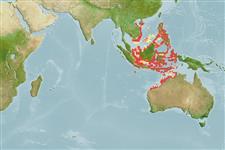>
Eupercaria/misc (Various families in series Eupercaria) >
Nemipteridae (Threadfin breams, Whiptail breams)
Etymology: Pentapodus: Greek, pente = five + Greek, pous = feet (Ref. 45335).
Eponymy: James Barker Emery (ca: 1794–1889) was a gifted artist and amateur naturalist who joined the Royal Navy (1808) and was First Lieutenant aboard the ‘Beagle’ during a survey of the Australian coast (1837–1841). [...] (Ref. 128868), visit book page.
More on author: Richardson.
Environment: milieu / climate zone / depth range / distribution range
Ecologia
marinhas associadas(os) a recifes; intervalo de profundidade 2 - 35 m (Ref. 90102). Tropical; 19°N - 23°S, 104°E - 131°E (Ref. 3810)
Western Pacific: Philippines, Indonesia, and northwestern Australia.
Tamanho / Peso / Idade
Maturity: Lm ? range ? - ? cm
Max length : 35.0 cm TL macho/indeterminado; (Ref. 90102); common length : 18.0 cm SL macho/indeterminado; (Ref. 3810)
Espinhos dorsais (total) : 10; Raios dorsais (total) : 9; Espinhos anais: 3; Raios anais : 7. Head scales reaching forward to level of posterior nostrils. Suborbital naked. Lower limb of preopercle with 2 or 3 scale rows. Pelvic fins moderately long, reaching almost to level of anus. Axillary scale present. Color: Upper body blue, lower white.
Found on clear coastal reef slopes (Ref. 48635). A solitary species (Ref. 9710) but may be found also in groups (Ref. 90102). Excellent eye-sight (Ref. 48635). Feeds on small fishes, crustaceans, ophiuroids and sipunculid worms.
Ciclo de vida ou comportamento de acasalamento
Maturidade | Reprodução | Desova | Ovos | Fecundidade | Larvas
Russell, B.C., 1990. FAO Species Catalogue. Vol. 12. Nemipterid fishes of the world. (Threadfin breams, whiptail breams, monocle breams, dwarf monocle breams, and coral breams). Family Nemipteridae. An annotated and illustrated catalogue of nemipterid species known to date. FAO Fish. Synop. 125(12):149p. Rome: FAO. (Ref. 3810)
Status na Lista Vermelha da UICN (Ref. 130435: Version 2024-1)
Ameaça para os humanos
Harmless
Uso pelos humanos
Pescarias: pesca de subsistência
Ferramentas
Relatórios especiais
Baixar XML
Fontes da internet
Estimates based on models
Preferred temperature (Ref.
123201): 27.2 - 29.1, mean 28.7 °C (based on 1099 cells).
Índice de diversidade filogenética (Ref.
82804): PD
50 = 0.5002 [Uniqueness, from 0.5 = low to 2.0 = high].
Bayesian length-weight: a=0.01445 (0.00683 - 0.03057), b=2.98 (2.81 - 3.15), in cm total length, based on LWR estimates for this (Sub)family-body shape (Ref.
93245).
Nível Trófico (Ref.
69278): 3.6 ±0.50 se; based on food items.
Resiliência (Ref.
120179): médio(a), tempo mínimo de duplicação da população 1,4 - 4,4 anos (Preliminary K or Fecundity.).
Fishing Vulnerability (Ref.
59153): Low vulnerability (25 of 100).
Nutrients (Ref.
124155): Calcium = 49.2 [31.0, 97.9] mg/100g; Iron = 0.613 [0.302, 1.522] mg/100g; Protein = 19.1 [17.2, 20.8] %; Omega3 = 0.142 [0.087, 0.236] g/100g; Selenium = 29.1 [17.4, 51.3] μg/100g; VitaminA = 71 [21, 200] μg/100g; Zinc = 1.18 [0.83, 1.69] mg/100g (wet weight);
